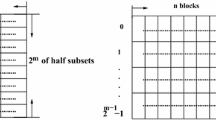Abstract
Data caches are widely used in general-purpose processors as a means to hide long memory latencies. Set-associativity in these caches helps programs avoid performance problems due to cache-map** conflicts. Current set-associative caches are symmetric in the sense that each way has the same number of cache lines. Moreover, each way is searched in parallel so energy is consumed by all ways even though at most one way will hit. With this in mind, this chapter proposes an asymmetric cache structure in which the size of each way can be different. The ways of the cache are different powers of two and allow for a “tree-structured” cache in which extra associativity can be shared. We accomplish this by having two cache blocks from the larger ways align with individual cache blocks in the smaller ways. This structure achieves performance comparable to a conventional cache of similar size and equal associativity. Most notably, the asymmetric cache has the nice property that accesses hit in the smaller ways can immediately terminate accesses to larger ways so that power can be saved. For the SPEC2000 benchmarks, we found cache energy per access was reduced by as much as 23% on average. The characteristics of the asymmetric set-associative design (lowpower, uncompromised performance, compact layout) make them particularly attractive for low-power processors.
Access this chapter
Tax calculation will be finalised at checkout
Purchases are for personal use only
Preview
Unable to display preview. Download preview PDF.
Similar content being viewed by others
References
Agarwal A and Pudar S (1992) Column-associative caches: A technique for reducing the miss rate of direct-mapped caches. In: Proceedings of the 20th Annual International Symposium on Computer Architecture.
Bodin F and Seznec A (1995) Skewed associativity enhances performance predictability. In: Proceedings of the 22nd Annual International Symposium on Computer Architecture.
Burger D, Austin T, and Bennett S (1996) Evaluating future microprocessors: The SimpleScalar tool set. Technical Report TR-1308, University of Wisconsin-Madison Computer Sciences Department.
Calder B, Grunwald D, and Emer J (1996) Predictive sequential associative cache. In: Proceedings of the 2nd Annual International Symposium on High Performance Computer Architecture.
Chang J H, Chao J, and So K (1987) Cache design of a sub-micron CMOS system370. In: Proceedings of the 14th Annual International Symposium on Computer Architecture.
SPEC Corporation (2000) WWW site http://www.spec.org.
Diodato P (2001) PersOnal communication.
Gwennap, L (1996) Digital 21264 sets new standard. Microprocessor Report, October 1996, pp. 11–16.
Hill M and Smith A (1989) Evaluating associativity in CPU caches. IEEE Transactions on Computers (38)12:1612–1630.
Inoue K, Ishihara T, and Murakami K (1999) Way-predicting set-associative cache for high performance and low energy consumption. In: Proceedings of the 1999 International Symposium on Low Power Electronics and Design.
Johnson M and Mangione-Smith W. (1997) The filter cache: An energy efficient memory structure. In: Proceedings of the 30th Annual International Symposium on Microarchitecture.
Jouppi N (1990) Improving direct-mapped cache performance by the addition of a small fully-associative cache and prefetch buffers. In: Proceedings of the 17th Annual International Symposium on Computer Architecture.
Juan T, Lang T, and Navarro J (1996) The difference-bit cache. In: Proceedings of the 23rd Annual International Symposium on Computer Architecture.
Kaxiras S, Hu Z, and Martonosi M (2001) Cache decay: exploiting generational behavior to reduce cache leakage power. In: Proceedings of the 28th Annual International Symposium on Computer Architecture.
Kessler R, Jooss R, Lebeck A, and Hill M (1989) Inexpensive implementation of set-associativity. In: Proceedings of the 16th Annual International Symposium on Computer Architecture, pp. 131–139.
Villa L, Zhang M, and Asanovic K (2000) Dynamic zero compression for cache energy reduction. In: Proceedings of the 33rd Annual IEEE/ACM International Symposium on Microarchitecture.
Milutinovic V, Markovic B and Tremblay M (1996) The split temporal/spacial cache: initial performance analysis. In: Proceedings of the SCIzzL-5.
Peir J, Lee Y, and Hsu W (1998) Capturing dynamic memory reference behavior with adaptive cache topology. In: Proceedings of the Eighth International Conference on Architectural Support for Programming Languages and Operating Systems.
Prvulovic M, Marinov D, Dimitrijevic Z and Milutinovic C (1999) The split spatial/non-spacial cache: a performance and complexity analysis. In: IEEE TCCA Newsletter.
Sahuquillo J and Pont A (2000) Splitting the data cache: a survey. IEEE Concurrency 8(3):30–35.
Seznec A (1993) A case for two-way skewed-associative caches. In: Proceedings of the 20th Annual International Symposium on Computer Architecture, pp. 169–178.
Seznec A (1995) DASC cache. In: Proceedings of the 1st Annual International Symposium on High Performance Computer Architecture.
Shivakumar P, and Jouppi N (2001) Cacti 3.0: An integrated cache timing, power, and area model. Technical Report 2001/2, Compaq Western Research Lab.
Tremblay M and O’Connor J (1996) UltraSparcI: A four-issue processor supporting multimedia. IEEE Micro (16)2:42–50.
Wilton S and Jouppi N (1994) An enhanced access and cycle time model for on-chip caches TR 1993/5, Compaq Western Research Lab.
Yeager K. (1996) The MIPS R10000 superscalar microprocessor. IEEE Micro (16)2:28–40.
Zhang C, Zhang X, Yan Y (1997) Two fast and high-associativity cache schemes. IEEE Micro (17)5:40–49.
Author information
Authors and Affiliations
Editor information
Editors and Affiliations
Rights and permissions
Copyright information
© 2004 Springer Science+Business Media New York
About this chapter
Cite this chapter
Hu, Z., Kaxiras, S., Martonosi, M. (2004). Improving Power Efficiency with an Asymmetric Set-Associative Cache. In: Hadimioglu, H., Kuskin, J., Torrellas, J., Kaeli, D., Nanda, A. (eds) High Performance Memory Systems. Springer, New York, NY. https://doi.org/10.1007/978-1-4419-8987-1_6
Download citation
DOI: https://doi.org/10.1007/978-1-4419-8987-1_6
Publisher Name: Springer, New York, NY
Print ISBN: 978-1-4612-6477-4
Online ISBN: 978-1-4419-8987-1
eBook Packages: Springer Book Archive




